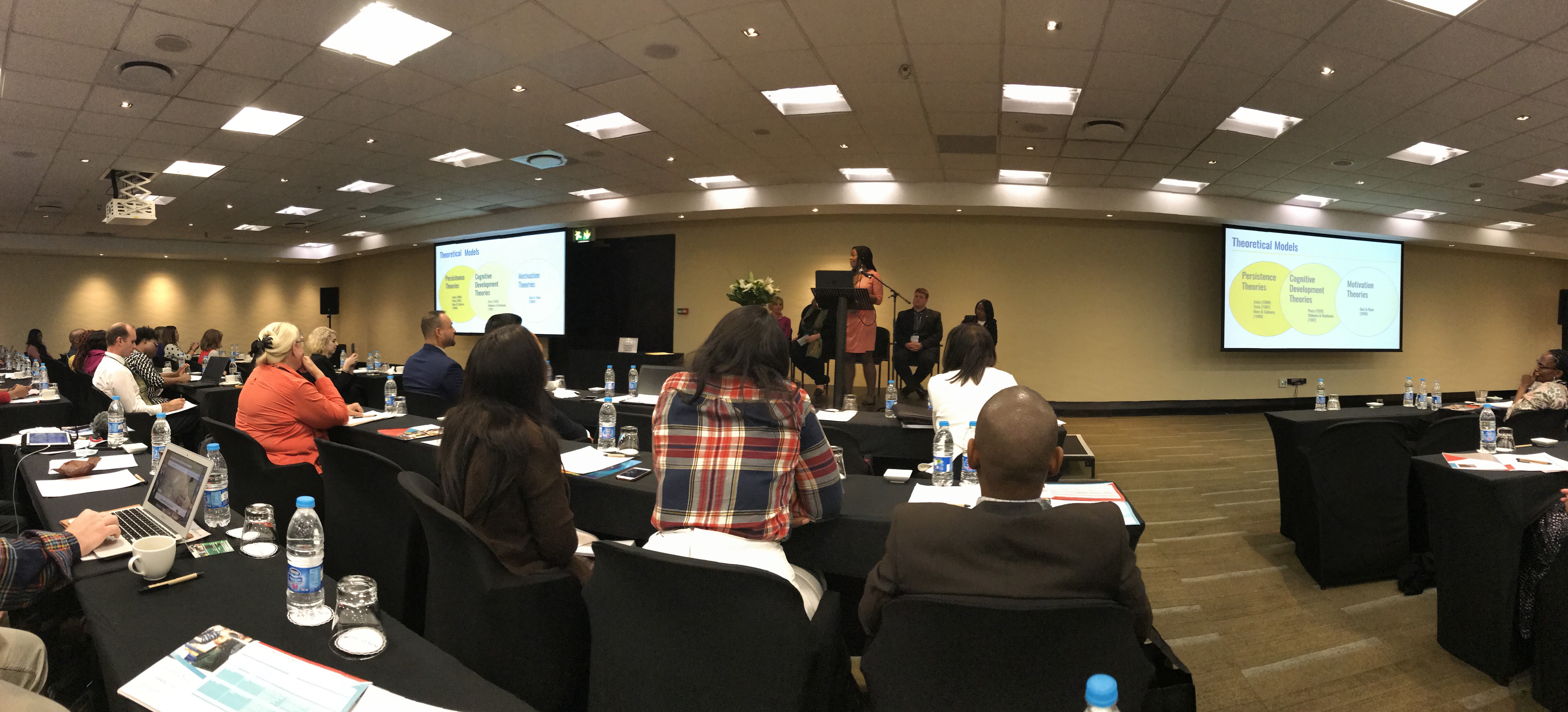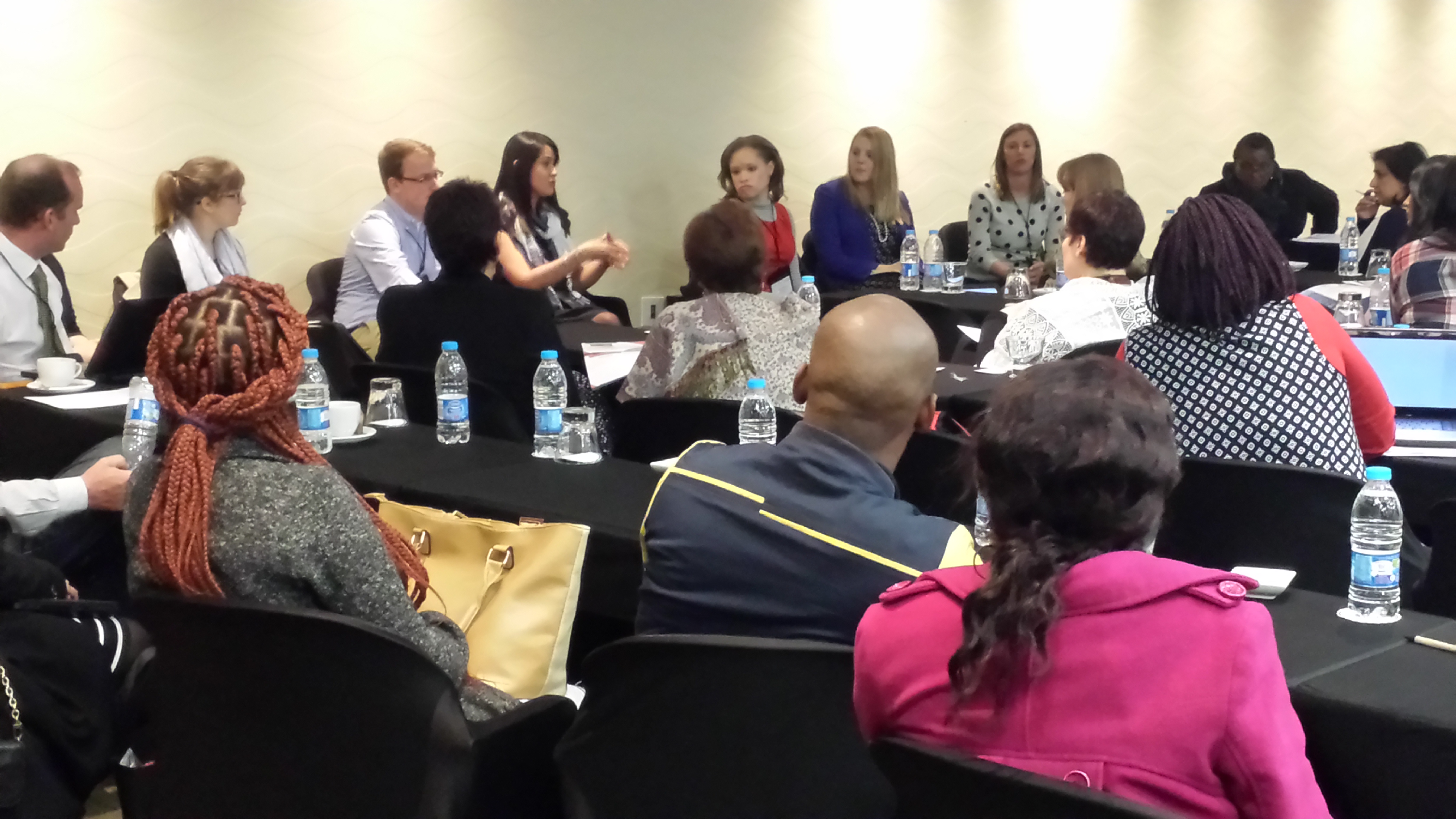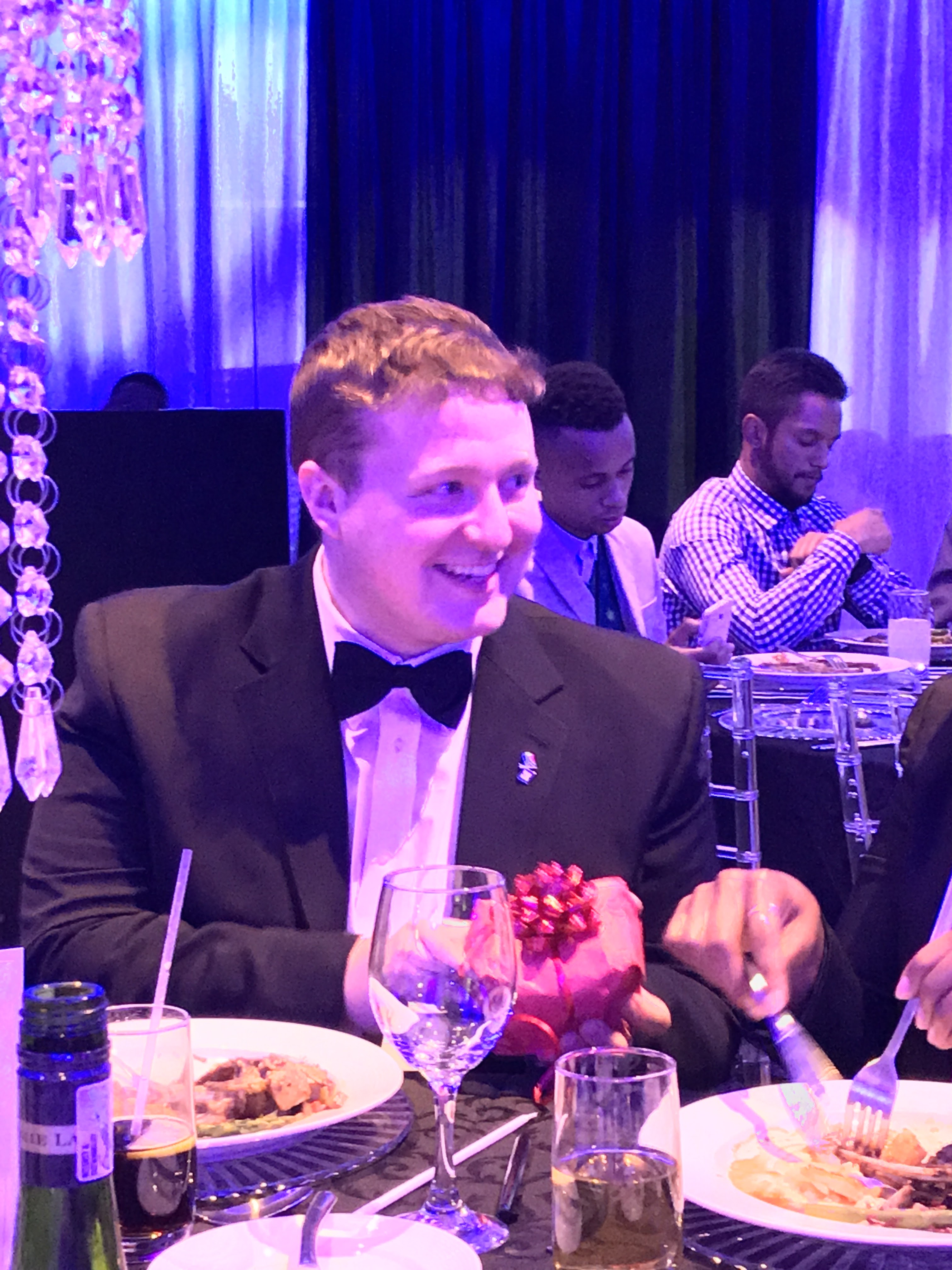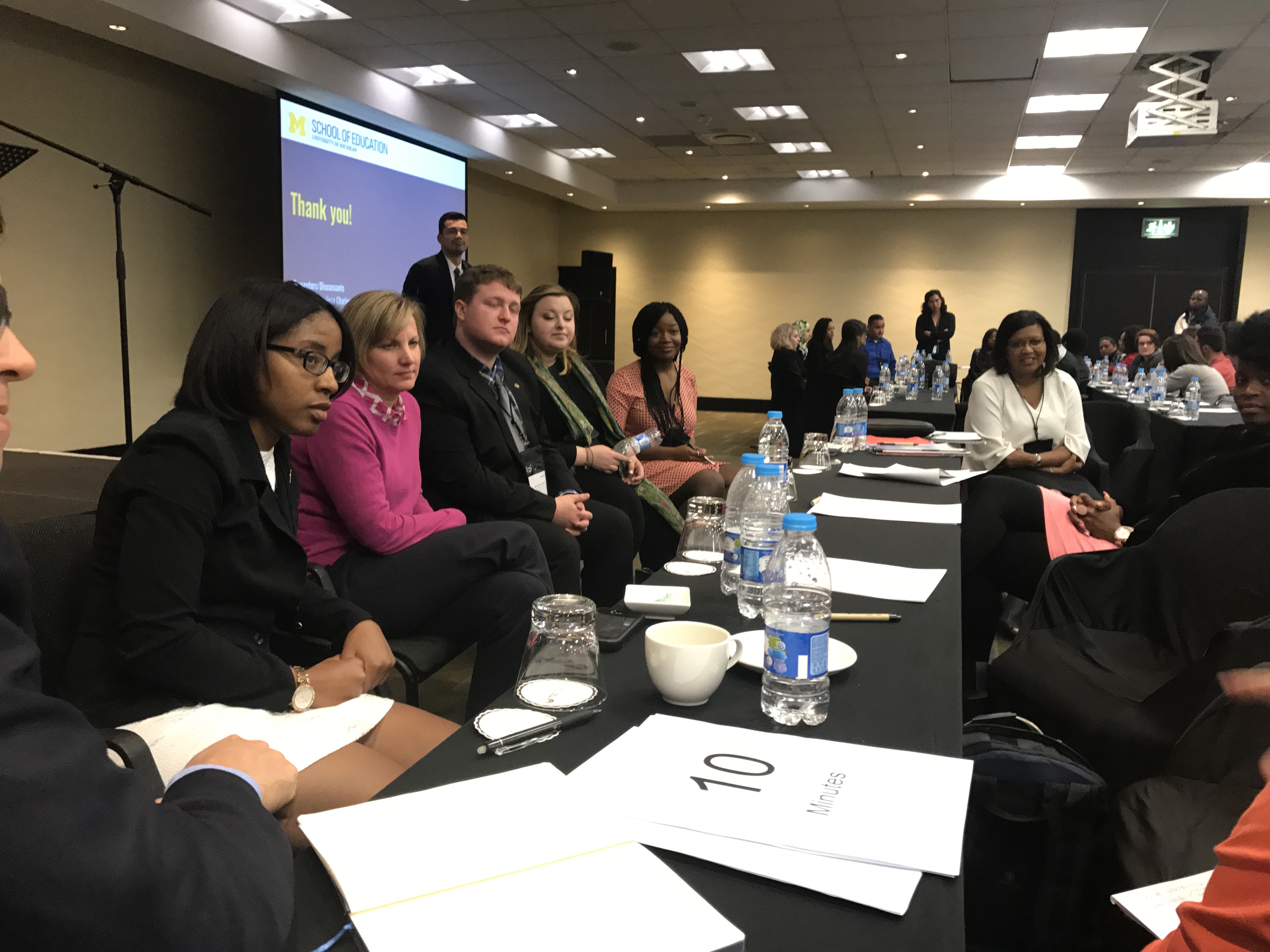During the planning for this study trip, an exciting opportunity for the group to be involved in the SANRC First-Year Experience conference presented itself. Over the ensuing months leading up to our trip, members of our group work in teams to develop conference presentations. The conference organizers then propose to feature the U-M presentations within the framework of the conference’s standing ‘Global FYE Perspectives’ session. We are greatly honored by this privilege to share with conference attendees.
Master’s students Reuben Kapp and Javier Solorzano Parada serve as MCs for the two-hour session.

They do a masterful job introducing each of three presentations by their peers.

CSHPE presentation titles include:
- “Low -income and Underrepresented Students and the First Year Experience: Bridging and Transitioning into College“
- “Creating a Sense of Belonging: Building Models of Individual and Community Belonging in Institutional Settings“
- “The First Year Experience: Living-Learning Models and Residence Life”

The SANRC conference keynote speaker, Dr. Tia Brown McNair, of the Association of American Colleges & Universities, serves as our discussant. And following her comments our students led small-group conversations with attendees interested in each of the respective presentation topics.

On Thursday evening, we attend the conference’s gala dinner event to let our hair down with new friends. During the event, CSHPE’s own Darin Martin is recognized (by committee!) as the Best Dressed Man, and is described as “a young James Bond” to the crowd.

SANRC 1st-year experience conference
From May 24 through May 26, we participated in the South African National Resource Centre First Year Experience (SANRC FYE). 2017 was the third year of the annual conference, which gathered practitioners and scholars from South Africa and elsewhere whose work relates to the first year experience. The conference covered a range of topics, from discussions about the priorities of higher education in the first year and beyond, to discussions of particular interventions or teaching strategies, to exploring the experiences of students in their transition to university, to professional development advice for scholars and practitioners in the field.
The first day of the conference began with a tea and coffee hour, followed by an introduction from the campus organizers and a keynote address by Dr. Birgit Schreiber, Director of Student Affairs at Stellenbosch University. Dr. Schreiber encouraged us to consider how higher education is preparing students to excel in a complex, often uncertain world, advocating using FYE programming to facilitate the development of cognitive fluidity and complex thinking skills. The remainder of the day consisted of breakout sessions with presentations on a number of topics. One memorable session by Dr. Elizabeth Sipiwe Ndofirepi discussed the diverse home communities of the students on a university campus and explored the complex and varied meanings of different shared spaces on that campus to the students who occupy them.
The second day of the conference began with a keynote address by Dr. Tia Brown McNair, Vice President, Office of Diversity, Equity, and Student Success for the AAC&U. Dr. Brown McNair challenged the notion of “college-ready students” and instead urged the audience to consider what it would mean to be a “student-ready college” or a “student-ready educator,” prepared to best support all students when they arrive on campus. Day Two of the conference also contained a session that included presentations by many members of our group, moderated by Dr. Brown NcNair. Three teams of CSHPE students worked together in the months preceding the conference to prepare presentations on different aspects of the First Year Experience in a United States context: Fostering a Sense of Belonging, Bridge or Transition Programs, and Living Learning Communities. After each group presented, we had the chance to participate in breakout discussion groups with South African educators, who raised many interesting questions and shared their experiences with each topic in a South African context.
Later that evening, we joined our fellow conference attendees for an elegant Gala Dinner. We enjoyed a delicious dinner (complete with Malva pudding, a rich South African dessert we enjoyed many times on our trip). Dinner included a moving talk by one South African student about her persistence in her pursuit of higher education in the face of many challenges, who spoke to importance of colleges and universities better meeting the call to be truly student-ready and supportive. Following dinner were the much-hyped “best dressed” awards. We’re proud to say our very own Darin Martin (sporting a classic black bowtie) won the award for best dressed man! The evening was capped off by a night of dancing, with everyone showing off their best moves on the dance floor.
The last day of the conference was a half day of programming. The final keynote address was given by Professor Ian Scott, an emeritus professor in higher education development at the University of Cape Town and a series of final workshop offerings concluded the conference. Over the three days, the content varied greatly in expected and unexpected ways. Sessions often reminded us of the many varied challenges that higher education institutions, and the students, faculty, and staff within them, are faced with in South Africa. In particular, several of the sessions dealt with topics ranging from the marked disparities in student experiences and outcomes that exist along socioeconomic and racial lines, to addressing the technology gap which included students who had no experience using a computer and the added challenge that creates for them as they transition into university, to creating nurturing and supportive learning environments in large lecture mathematics courses, to male attitudes toward contraceptives and university efforts to reduce unplanned pregnancies and STIs among their student body. It was an insightful three days and broadened our understandings of the higher education environment in South Africa which further helped set the stage for our subsequent visits to universities during the rest of the trip.
–Ann Luke, master’s student, and Erika Mosyjowski, doctoral candidate
*****************************************************
Reflections of an MC
Part of our experience in South Africa was the amazing opportunity to present at the 2017 SANRC First-Year Experience Conference. Our groups worked together to create three presentations focusing on the Global first year experience – specifically highlighting the work at the University of Michigan. We kept in mind that we would be visitors to the country and to the conference. We made sure to think very deeply about the language we would use during our presentations but also the takeaway we would want our audience to leave with.

I believe that the university (South Africa) visits prior to the conference helped our presenters think about what sense of belonging, transition, and living learning communities looked like in South African higher education. People from the three different presentation groups were given the opportunity to listen to faculty, staff, and I believe most importantly students during the many university trips. These folks shared valuable information to the presenters who then were able to include or incorporate in their presentations.

As an MC for our session, I felt that we received positive feedback from the professionals attending the conference. I was pleasantly surprised by all of the questions that were brought up during the small dialogic sessions. Folks surfaced questions about aligning our work to the current higher education models in South Africa, expressing that funding is a major pushback with their work. Folks also seemed very interested to learn more about our U.S. higher education system, the many programs that are offered to students and the K-12 education system. Here is a link to a short video that highlights some of the dialogue that occurred after the presentations.
–Javier Solorzano Parada, master’s student
